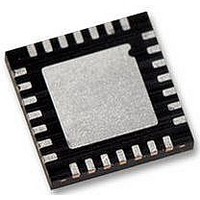PIC16LF1938-I/ML Microchip Technology, PIC16LF1938-I/ML Datasheet - Page 135

PIC16LF1938-I/ML
Manufacturer Part Number
PIC16LF1938-I/ML
Description
IC MCU 8BIT FLASH 28QFN
Manufacturer
Microchip Technology
Series
PIC® XLP™ 16Fr
Specifications of PIC16LF1938-I/ML
Core Size
8-Bit
Program Memory Size
28KB (16K x 14)
Core Processor
PIC
Speed
32MHz
Connectivity
I²C, LIN, SPI, UART/USART
Peripherals
Brown-out Detect/Reset, LCD, POR, PWM, WDT
Number Of I /o
25
Program Memory Type
FLASH
Eeprom Size
256 x 8
Ram Size
1K x 8
Voltage - Supply (vcc/vdd)
1.8 V ~ 3.6 V
Data Converters
A/D 11x10b
Oscillator Type
Internal
Operating Temperature
-40°C ~ 85°C
Package / Case
28-VQFN Exposed Pad, 28-HVQFN, 28-SQFN, 28-DHVQFN
Controller Family/series
PIC16LF
Eeprom Memory Size
256Byte
Ram Memory Size
1024Byte
Cpu Speed
32MHz
No. Of Timers
5
Lead Free Status / RoHS Status
Lead free / RoHS Compliant
Available stocks
Company
Part Number
Manufacturer
Quantity
Price
Part Number:
PIC16LF1938-I/ML
Manufacturer:
MICROCHIP/微芯
Quantity:
20 000
- Current page: 135 of 508
- Download datasheet (5Mb)
12.3
PORTB is an 8-bit wide, bidirectional port. The
corresponding
(Register 12-7). Setting a TRISB bit (= 1) will make the
corresponding PORTB pin an input (i.e., put the
corresponding output driver in a High-Impedance mode).
Clearing a TRISB bit (= 0) will make the corresponding
PORTB pin an output (i.e., enable the output driver and
put the contents of the output latch on the selected pin).
Example 12-2 shows how to initialize PORTB.
Reading the PORTB register (Register 12-6) reads the
status of the pins, whereas writing to it will write to the
PORT latch. All write operations are read-modify-write
operations. Therefore, a write to a port implies that the
port pins are read, this value is modified and then written
to the PORT data latch (LATB).
The TRISB register (Register 12-7) controls the PORTB
pin output drivers, even when they are being used as
analog inputs. The user should ensure the bits in the
TRISB register are maintained set when using them as
analog inputs. I/O pins configured as analog input always
read ‘0’.
12.3.1
Each of the PORTB pins has an individually configurable
internal weak pull-up. Control bits WPUB<7:0> enable or
disable each pull-up (see Register 12-10). Each weak
pull-up is automatically turned off when the port pin is
configured as an output. All pull-ups are disabled on a
Power-on Reset by the WPUEN bit of the OPTION
register.
12.3.2
All of the PORTB pins are individually configurable as an
interrupt-on-change pin. Control bits IOCB<7:0> enable
or disable the interrupt function for each pin. The
interrupt-on-change feature is disabled on a Power-on
Reset.
“Interrupt-On-Change” for more information.
2009 Microchip Technology Inc.
PORTB Registers
WEAK PULL-UPS
INTERRUPT-ON-CHANGE
data
Reference
direction
register
Section 13.0
is
TRISB
Preliminary
12.3.3
The ANSELB register (Register 12-9) is used to
configure the Input mode of an I/O pin to analog.
Setting the appropriate ANSELB bit high will cause all
digital reads on the pin to be read as ‘0’ and allow
analog functions on the pin to operate correctly.
The state of the ANSELB bits has no affect on digital
output functions. A pin with TRIS clear and ANSELB set
will still operate as a digital output, but the Input mode
will be analog. This can cause unexpected behavior
when executing read-modify-write instructions on the
affected port.
EXAMPLE 12-2:
BANKSEL PORTB
CLRF
BANKSEL LATB
CLRF
BANKSEL ANSELB
CLRF
BANKSEL TRISB
MOVLW
MOVWF
PIC16F193X/LF193X
Note:
PORTB
LATB
ANSELB
B’11110000’ ;Set RB<7:4> as inputs
TRISB
ANSELB REGISTER
The ANSELB register must be initialized to
configure an analog channel as a digital
input. Pins configured as analog inputs will
read ‘0’.
INITIALIZING PORTB
;
;Init PORTB
;Data Latch
;
;Make RB<7:0> digital
;
;and RB<3:0> as outputs
;
DS41364D-page 135
Related parts for PIC16LF1938-I/ML
Image
Part Number
Description
Manufacturer
Datasheet
Request
R

Part Number:
Description:
IC, 8BIT MCU, PIC16LF, 32MHZ, QFN-28
Manufacturer:
Microchip Technology
Datasheet:

Part Number:
Description:
IC, 8BIT MCU, PIC16LF, 32MHZ, QFN-28
Manufacturer:
Microchip Technology
Datasheet:

Part Number:
Description:
IC, 8BIT MCU, PIC16LF, 32MHZ, DIP-18
Manufacturer:
Microchip Technology
Datasheet:

Part Number:
Description:
IC, 8BIT MCU, PIC16LF, 20MHZ, TQFP-44
Manufacturer:
Microchip Technology
Datasheet:

Part Number:
Description:
7 KB Flash, 384 Bytes RAM, 32 MHz Int. Osc, 16 I/0, Enhanced Mid Range Core, Nan
Manufacturer:
Microchip Technology

Part Number:
Description:
14KB Flash, 512B RAM, LCD, 11x10b ADC, EUSART, NanoWatt XLP 28 SOIC .300in T/R
Manufacturer:
Microchip Technology
Datasheet:

Part Number:
Description:
14KB Flash, 512B RAM, LCD, 11x10b ADC, EUSART, NanoWatt XLP 28 SSOP .209in T/R
Manufacturer:
Microchip Technology
Datasheet:

Part Number:
Description:
MCU PIC 14KB FLASH XLP 28-SSOP
Manufacturer:
Microchip Technology

Part Number:
Description:
MCU PIC 14KB FLASH XLP 28-SOIC
Manufacturer:
Microchip Technology

Part Number:
Description:
MCU PIC 512B FLASH XLP 28-UQFN
Manufacturer:
Microchip Technology

Part Number:
Description:
MCU PIC 14KB FLASH XLP 28-SPDIP
Manufacturer:
Microchip Technology

Part Number:
Description:
MCU 7KB FLASH 256B RAM 40-UQFN
Manufacturer:
Microchip Technology

Part Number:
Description:
MCU 7KB FLASH 256B RAM 44-TQFP
Manufacturer:
Microchip Technology

Part Number:
Description:
MCU 14KB FLASH 1KB RAM 28-UQFN
Manufacturer:
Microchip Technology

Part Number:
Description:
MCU PIC 14KB FLASH XLP 40-UQFN
Manufacturer:
Microchip Technology











